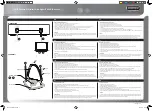
Installation
ST94-21 C/Ku-Band TVRO
3-2
3.2.
Site Selection Aboard Ship
The radome assembly should be installed at a location aboard ship where:
•
The antenna has a clear line-of-sight to view as much of the sky (horizon to zenith at all bearings) as is
practical.
•
X-Band (3cm) Navigational Radars:
•
The ADE should be mounted more than 0.6 meters/2 feet from 2kW (24 km) radars
•
The ADE should be mounted more than 2 meters/8 feet from 10kW (72 km) radars
•
The ADE should be mounted more than 4 meters/12 feet from 160kW (250km) radars
•
S-Band (10cm) Navigational Radars:
•
If the ADE is/has C-Band it should be mounted more than 4 meters/12 feet from the S-band Radar.
•
The ADE should not be mounted on the same plane as the ship's Radar, so that it is not directly in the Radar
beam path.
•
The ADE should be mounted more than 2.5 meters/8 feet from any high power MF/HF antennas (<400W).
•
The ADE should be mounted more than 4 meters/12 feet from any high power MF/HF antennas (1000W).
•
The ADE should also be mounted more than 4 meters/12 feet from any short range (VHF/UHF) antennae.
•
The ADE should be mounted more than 2.5 meters/8 feet away from any L-band satellite antenna.
•
The ADE should be mounted more than 3 meters/10 feet away from any magnetic compass installations.
•
The ADE should be mounted more than 2.5 meters/8 feet away from any GPS receiver antennae.
•
Another consideration for any satellite antenna mounting is multi-path signals (reflection of the satellite
signal off of nearby surfaces arriving out of phase with the direct signal from the satellite) to the antenna.
This is particularly a problem for the onboard GPS, and/or the GPS based Satellite Compass.
•
The Above Decks Equipment (ADE) and the Below Decks Equipment (BDE) should be positioned as close to
one another as possible. This is necessary to reduce the losses associated with long cable runs.
•
This mounting platform must also be robust enough to withstand the forces exerted by full rated wind load
on the radome.
•
The mounting location is robust enough that it will not flex or sway in ships motion and be sufficiently well
re-enforced to prevent flex and vibration forces from being exerted on the antenna and radome.
•
If the radome is to be mounted on a raised pedestal, it MUST have adequate size, wall thickness and gussets
to prevent flexing or swaying in ships motion. In simple terms it must be robust.
If these conditions cannot be entirely satisfied, the site selection will inevitably be a “best” compromise between the
various considerations.
3.3.
Preparation
It is recommended that you do not unpack the crates until you are ready to sub-assemble and install the equipment.
Assure that you have a large, flat, level, open area to sub-assembly the baseframe, pedestal, dish/feed and the upper &
lower sections of the radome. This area should be clean and free of debris (refer to the Installation chapters of
Antenna and Antenna Control Unit manuals).
We recommend that you place the crates in the area that you have chosen to assembly each of these major
components.
3.4.
Opening your crates
CAUTION:
To prevent items from being lost or misplaced, do not unpack this
crate until you are ready to assemble and install the equipment.
EAR Controlled - ECCN EAR99
Summary of Contents for ST94-21
Page 4: ...EAR Controlled ECCN EAR99 ...
Page 10: ...Table of Contents x This Page Intentionally Left Blank EAR Controlled ECCN EAR99 ...
Page 123: ...EAR Controlled ECCN EAR99 ...
Page 126: ...EAR Controlled ECCN EAR99 ...
Page 139: ...EAR Controlled ECCN EAR99 ...
Page 140: ...EAR Controlled ECCN EAR99 ...
Page 141: ...EAR Controlled ECCN EAR99 ...
















































